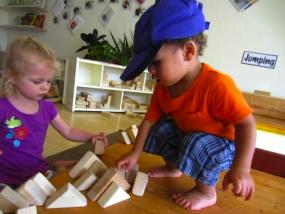Helping Toddlers Help Each Other

Marley, 26 months old, and Dutch, 23 months old, are learning to negotiate social rules surrounding their play with blocks. Marley has a clear goal in mind as she works to arrange triangle shaped blocks in a row along the edge of the raised platform. Dutch asks, “What those?” as he uses a rectangular block to begin sliding the triangle shaped blocks off the edge. Summer, the children’s teacher, recognizes that Dutch is having some trouble entering the play and treats this as an opportunity to scaffold the children’s interaction. She encourages Dutch to listen to his peer’s words, “No, stop,” and think about what they mean. Recognizing that once an action is started, it is often challenging for young children to stop, the teacher helps Dutch become more aware of his own body by gently touching his forearm (00:15). To communicate excitement about the opportunity for collaboration, the teacher uses a rising inflection in her voice as she invites Dutch to join the play (00:26). Dutch accepts. The teacher then carefully works to help Dutch develop a set of strategies for entering the play successfully. She encourages Dutch to observe Marley’s play and suggests he take on the role of helper by saying, “Okay, so let’s look at what she’s doing here. Let’s look at what she’s doing and how we can help her” (00:27). She models specific words Dutch can use to talk to his peer by saying, “Marley can you – let’s ask Marley what she is doing. Say, ‘Marley, what are you doing?’” (00:33). When other activities in the classroom capture the children’s attention, the teacher remains patient, waiting to see if the children are interested in continuing their work together. Dutch approaches, and the teacher renews her invitation by saying, “Okay, let’s see, Dutch, let’s ask Marley what she’s doing” (01:37). Dutch proposes a new idea. He says, “They’re going on the top,” as he works to balance a large triangle atop a small triangle (01:46). Dutch discovers the large triangle does not align atop the small triangle, so he revises his strategy and instead balances a small triangle atop a large triangle (01:49). Dutch begins to walk away with two triangles, and Marley employs a strategy modeled by their teacher. She poses an invitation by saying, “Stop. Want to help me? Want to help me, Summer?” (01:59). Quickly, the teacher again encourages the children’s collaboration by saying, “Yeah, I’ll help you, Marley. Dutch do you want to help too?” (02:04). Recognizing that Dutch wants to engage with the blocks, the teacher offers a description of the actions that support Marley’s goal. While demonstrating she says, “It looks like we’re putting all the triangles over here” (02:08). Dutch decides to help. The teacher skillfully supports his participation by lending greater detail to the desired action. She says, “Setting them down with our hands” (02:12); “It doesn’t look like Marley’s throwing them (points as Marley places a triangle on the floor). What is Marley doing? She’s setting them down gently with her hands” (02:15). Dutch successfully modifies his actions in order to collaborate. He steps down from the platform and says, “Your hands,” as he gently sets a triangle down. It tips over and he rights it. Dutch says, “Your hands. Okay? Hands,” as he continues placing the remaining triangles on the floor (02:26-02:33). The children now work together as partners, searching for more triangles. Marley and Dutch engage in conversation. Dutch makes an overture by saying, “Here you go, Marley. Here you go” as he hands her a triangle (03:13). Accidentally, the block falls on her toe. Marley expresses discomfort by saying, “Ow! Owie, owie, owie” (03:18). The teacher hopes to continue supporting the children’s newly formed collaboration, so she decides to wait. She trusts that Marley will effectively communicate her feelings to Dutch, and that Dutch will respond in a way that meets Marley desires. Later on, Marley notices that Dutch has again stacked one triangle on top of another and says, “No, don’t top them on together” (04:04). Dutch begins driving a toy truck over the ramp-like angles of the triangle blocks. As he rolls the truck, Dutch uses an action word (“Rolling”) to characterize his play (04:24). Note that he also works to foster a reciprocal relationship by now asking Marley for her help. Marley readily agrees by saying, “How many triangle?” (05:02). The different orientations toward block play shown by Marley and Dutch remind us that arrangements are often more interesting to young girls, while actions on or with blocks are often more interesting to young boys. In that light, the early segment of the video where Dutch was pushing Marley's blocks off the edge of the platform could have been an expression of his desire to have the blocks do something. We invite you to watch this enjoyable video again. As you do so, consider how the teacher’s familiarity with the children gives her the information required to react quickly when help is needed, and to wait when help is not yet necessary. Think about what learning opportunities may have been missed if the teacher had redirected Dutch or encouraged him to play in another area of the classroom. Identify two instances that surprised you or made you feel uneasy and describe why. List several ways that revisiting this video with the children might enhance their learning and relationship.
